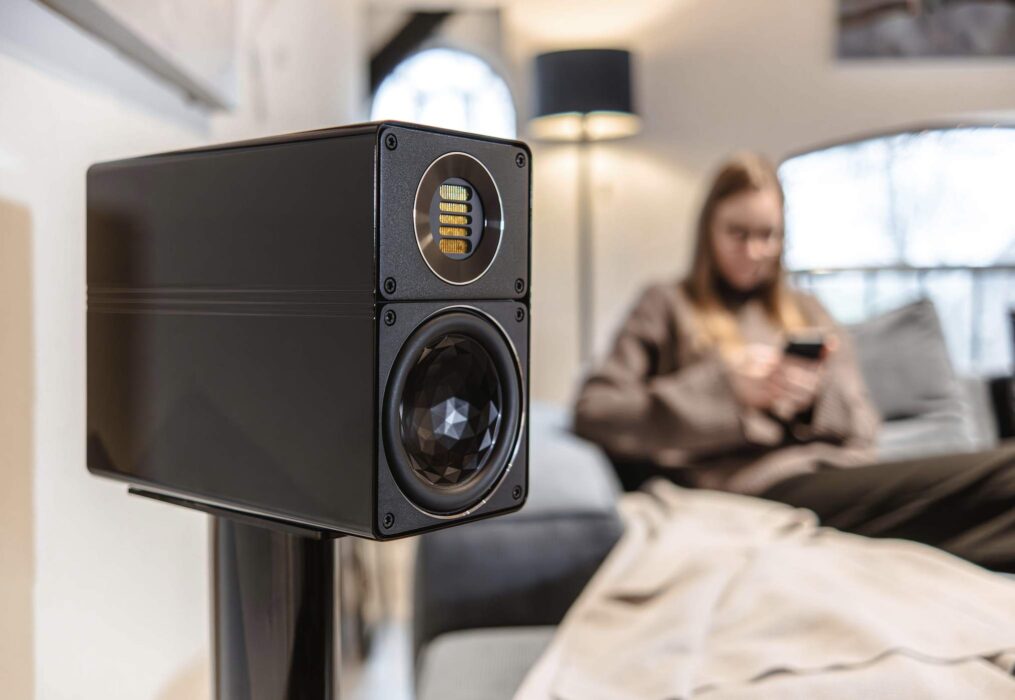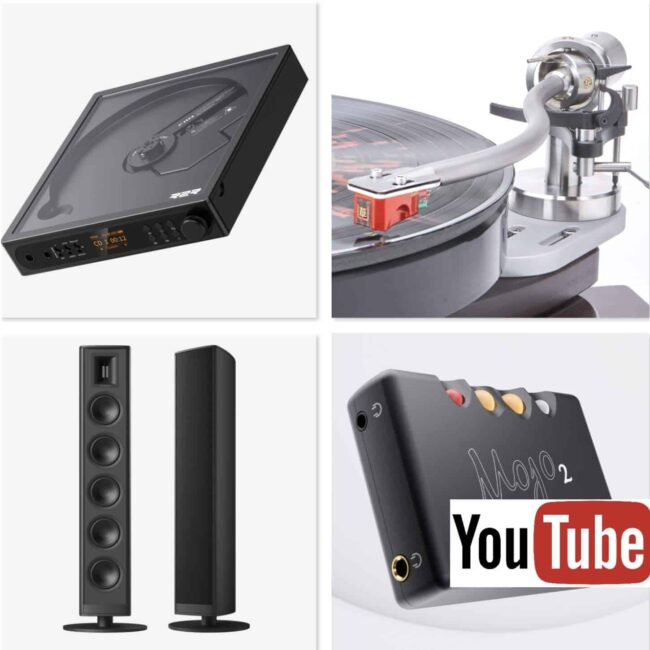The Article
312.2 SPEAKERS FROM ELAC
19th November 2024

Sporting both a Jet AMT tweeter and an intriguingly small form factor Paul Rigby, wonders how these ELAC 312.2 speakers will compare to the big boys
The ELAC speakers are strange and no mistake. Well, to my eyes if not yours. Looking straight, head on, the Elegant BS – an unfortunate name and I hope they aren’t BS really – 312.2 speakers look tiny, then you look around the corner and you’ll see the cabinet move back into 3D space for miles and miles.

In fact, the cabinet measures 208 x 122 x 270mm. But then there’s the weight. They are surprisingly heavy. Brace yourself before you pick them up as they hit 7.2kg. Part of the reason for this is at the unibody design built from aluminium. Yes, the cabinet is made from metal, not MDF. It also incorporates a bass reflex port on the rear.
ON THE FRONT
… is a small 115mm AS-XR mid/bass driver that apparently utilises a large voice coil and added magnet ring and that distinct crystal pattern within that promises good bass performance. We will see. Above is a JET 6 folded Air-Motion Transformer (AMT) tweeter fronted by a metal grill. The Jet 6 reportedly improves upon the Jet 5 with enhanced tracks and foil design.

Other components inside include air-core coils, metal-oxide resistors, MKP film capacitors and Van den Hul wiring.
Available in black high gloss and white high gloss finishes, the speakers can be bi-wired if you wish.

Once thing, these are 4 Ohm speakers and so will need a bit of a push to get them going. Anything from 50W upwards in amp terms will do fine. Finally, the speakers arrive with an aluminium/rubber combo tray that sits underneath and acts an isolation decoupling platform. I’ll be reviewing that and the 4 Ohm impedance on my valve monoblocks.
SOUND QUALITY
To begin the sound quality tests, I began with CD and Lush’s Tiny Smiles on the 4AD album, Spooky. Offering a twin female vocal presentation, lead, rhythm and bass guitars plus drums.
4 OHM PLAY
Because I used valve mono blocks as my amplifier reference and because valve amplifiers are rather more sensitive to impedance changes, I wanted to test my default 8 Ohm amplifier setting with the speaker-rated 4 Ohm. Hence, I swapped the speaker cables from one socket to another and listened for any changes.

Unlike many 4 Ohm speakers I’ve heard where the 4 Ohm option is the only real option (and in those cases the 8 Ohm pots can sound brash and relatively nasty) I was actually quite happy with either 4 or 8 Ohms via the ELACs. There were differences, the 4 Ohm playback sounded more laid back, midrange was open and airy.
The 8 Ohm selection dialled up the upper frequencies giving accentuated performances for both treble and upper mids whilst reducing space around the upper mids.

For this review though, I decided to stick with the 4 Ohm pots on the rear of my monoblocks. They provided a better balanced and neutral sound with that rather nice airy midrange feedback and bass that felt more integrated into the mix.

Also, the 4 Ohm option sounded superior when playing The Cure’s Wild Mood Swings CD, a mid-90s release that suffered from the excessive peak limiting disease of the time. That overly compressed sound was bearable in 4 Ohm mode but unlistenable in 8 Ohm mode.
TOEING IN
While I was tweaking, I also settled on toeing the speakers just outside my ears. Firing the ELACS directly at my ears was fine but I found angling them slightly outside a slight enhancement so I left them there.
ISOLATION DECOUPLERS
Next? I wanted to test the isolation decouplers, supplied in the box so tried those with and without. With? I heard enhanced clarity. That is, I could better hear cymbal taps which lurked at the rear of the mix while bass was better focused now, tighter and more precise. So I decided to keep the decouplers in place during the rest of the review.
VS EVO 4.2
Next? I compared the ELACs with the larger EVO 4.2 speakers from Wharfedale. Larger but cheaper by less than half the price, the EVO 4.2s provided an interesting challenge. Looking at the two pairs, the ELACs were more expensive but surely they couldn’t best the visually more impressive EVOs…could they?

And well, what a fascinating comparison this was. Firstly, I thought the EVO performance was excellent. I do like these speakers. Even so, the bass was not quite as impressive as the ELACs. Excellent for the price but the implementation wasn’t as effective. The ELACs integrated bass better and produced more impact to boot. In upper frequency terms? Again, integration was not quite as effective as the ELACs. How the sound was put together, those basic building blocks were better handled by the ELACs.

Generally? The sound from the ELACS was neater, tighter, slicker and tonally better balanced. The EVOs sounded slightly sloppy by comparison.
VS LEAK SANDWICH 150
I then drafted in the Leak Sandwich 150s, which are just as physically imposing as the EVOs. Again, around £650 cheaper than the ELACs, the Leaks sounded better organised than the EVOs with the upper frequencies offering a sense of logicality in how that part of the frequency spectrum was put together.
Comparing the Leaks to the ELACS? The mids and treble from the Leaks were integrated well, sounding detailed while excellent in terms of midrange insight, revealing that the Leaks are real bargains for anyone interested in big speakers. Bass was balanced too. In fact, the Leaks really pushed the ELACs, despite their lower cost, providing superb focus and precision around the mids.

The ELACs had the edge in treble terms, providing further extension, especially during delicate cymbal taps while the bass added further focus to give these diminutive ELACS real punch. The Leaks sounded larger, occupying more space but the ELACs had a slightly better tonality around the lower frequencies. It was close though.
But for those looking at a small footprint design and leaning towards a much smaller cabinet, the fact that the ELACs were even in the ‘big sound’ game was remarkable.
VS AURA 2
Comparing the ELACS to the Aura 2 speakers from Wharfedale which are a few hundred pounds dearer in price, the ELACs struggled. But for the price and that sheer size difference, I’m not surprised. The Aura 2s had now moved onto the next rung up the sonic ladder, leaving every other speaker in this test behind. The sense of detail and information from the Aura 2s, that tonal realism and imagery, was impressive.

Even so, the ELACs were never put to shame. They fought their corner and put up a fight. Sure, they lost every sonic round against the Aura 2s but the drew applause from me at just how well they performed considering both their price and their relative size.

Listening to vinyl and Frank Sinatra’s The World We Knew on Reprise and the duet with his daughter, Nancy on Somethin’ Stupid, I was impressed with the instrumental separation as each instrument in the orchestra found room for itself across the wide soundstage with strings on the right, horns wandering to the left and a pair of guitars and more on the far left. The clarity from this presentation fixed the attention on the performances.
CONCLUSION
The ELAC 312.2 speakers are – at least to me – very strange indeed. The aluminium casing, the extended cabinet, the high-end components in such a small form factor but the unexpected high quality performance most of all.

I expected sonic compromise along with the compromise in size but, for the most part, that never happened. I remained impressed through the review. Sure, the size did prove an issue when comparative designs were wheeled in but really? For those looking for a high-quality sound from a small footprint, low visibility, audiophile speaker, I can’t think, off the top of my head, of comparable competition.
The ELAC 312.2s are the surprise of 2024. And in a nice way.
ELAC Elegant BS 312.2 Speakers
Price: £1,649
Website: www.elac.com
GOOD: small footprint, structured bass, midrange detail, extended treble
BAD: nothing
RATING: 8



